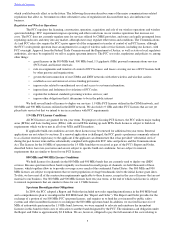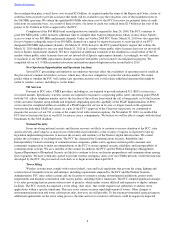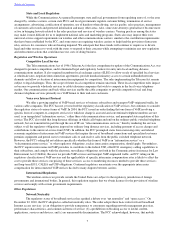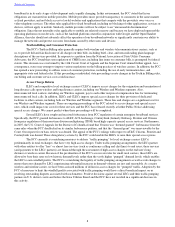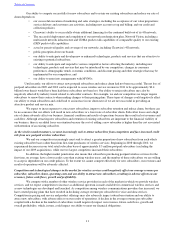Sprint - Nextel 2010 Annual Report Download - page 16
Download and view the complete annual report
Please find page 16 of the 2010 Sprint - Nextel annual report below. You can navigate through the pages in the report by either clicking on the pages listed below, or by using the keyword search tool below to find specific information within the annual report.
• seasonality or other variations in our subscriber base, including our rate of churn;
• announcements by us or our competitors of acquisitions, new products, technologies, significant contracts,
commercial relationships or capital commitments;
• the performance of Clearwire and Clearwire's Class A common stock or speculation about the possibility of
future actions we or other significant shareholders may take in connection with Clearwire;
• disruption to our operations or those of other companies critical to our network operations;
• announcements by us regarding the entering into, or termination of, material transactions;
• our ability to develop and market new and enhanced technologies, products and services on a timely basis,
including our 4G network;
• recommendations by securities analysts or changes in estimates concerning us;
• the incurrence of additional debt, dilutive issuances of our stock, short sales or hedging of, and other derivative
transactions in our common stock;
• any major change in our board of directors or management;
• litigation;
• changes in governmental regulations or approvals; and
• perceptions of general market conditions in the technology and communications industries, the U.S. economy
and global market conditions.
Consolidation and competition in the wholesale market for wireline services, as well as consolidation of our roaming
partners and access providers used for wireless services, could adversely affect our revenues and profitability.
Our Wireline segment competes with AT&T, Verizon, Qwest Communications, Level 3 Communications Inc., other
major local incumbent operating companies, and cable operators, as well as a host of smaller competitors, in the provision of
wireline services. Some of these companies have high-capacity, IP-based fiber-optic networks capable of supporting large
amounts of voice and data traffic. Some of these companies claim certain cost structure advantages that, among other factors,
may allow them to offer services at a price below that which we can offer profitably. In addition, consolidation by these
companies could lead to fewer companies controlling access to more cell sites, enabling them to control usage and rates, which
could negatively affect our revenues and profitability.
We provide wholesale services under long term contracts to cable television operators which enable these operators
to provide consumer and business digital telephone services. These contracts may not be renewed as they expire, generally in
the time period between 2011 and 2013. Increased competition and the significant increase in capacity resulting from new
technologies and networks may drive already low prices down further. AT&T and Verizon continue to be our two largest
competitors in the domestic long distance communications market. We and other long distance carriers depend heavily on local
access facilities obtained from ILECs to serve our long distance subscribers, and payments to ILECs for these facilities are a
significant cost of service for our Wireline segment. The long distance operations of AT&T and Verizon have cost and
operational advantages with respect to these access facilities because those carriers serve significant geographic areas,
including many large urban areas, as the incumbent local carrier.
In addition, our Wireless segment could be adversely affected by changes in rates and access fees that result from
consolidation of our roaming partners and access providers, which could negatively affect our revenues and profitability.
The blurring of the traditional dividing lines among long distance, local, wireless, video and Internet services contribute to
increased competition.
The traditional dividing lines among long distance, local, wireless, video and Internet services are increasingly
becoming blurred. Through mergers, joint ventures and various service expansion strategies, major providers are striving to
provide integrated services in many of the markets we serve. This trend is also reflected in changes in the regulatory
environment that have encouraged competition and the offering of integrated services.
We expect competition to intensify across all of our business segments as a result of the entrance of new competitors
or the expansion of services offered by existing competitors, and the rapid development of new technologies, products and
services. We cannot predict which of many possible future technologies, products, or services will be important to maintain our
competitive position or what expenditures we will be required to make in order to develop and provide these technologies,
products or services. To the extent we do not keep pace with technological advances or fail to timely respond to changes in the
competitive environment affecting our industry, we could lose market share or experience a decline in revenue, cash flows and
net income. As a result of the financial strength and benefits of scale enjoyed by some of our competitors, they may be able to
offer services at lower prices than we can, thereby adversely affecting our revenues, growth and profitability.
Table of Contents
14



